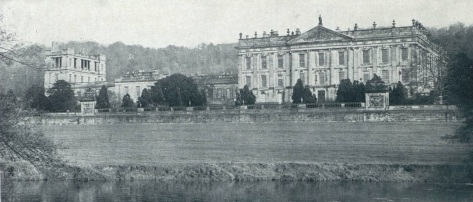A stately home without a Duke. How its treasures were cared for in the absence of the Duke of Devonshire

The domain of Chatsworth was purchased by Sir William Cavendish and it was he in 1553 who began the old mansion, which after his death in 1557 was completed by his widow, Bess of Hardwick. Here in succeeding years Mary Queen of Scots was five times imprisoned. The present mansion includes the old Palladian pile started in 1687 by the first Duke of Devonshire and the north-wing added in 1820.
With its 636,000 visitors a year, Chatsworth House may have become one of our greatest stately homes. However, life in the Duke of Devonshire’s grand mansion wasn’t always a bed of roses. In 1946, The Sphere painted a rather bleak and uninspiring outlook for the house, a stark contrast to its present-day fortunes.
Back then, ‘one of the private treasure-houses of the nation’ was reduced to one housemaid, a sole survivor of a pre-war domestic staff of forty, and the whole house was being kept on a caretaking basis.
Chatsworth House was without a Duke. Taxation of the time made it impossible for him to live there in the old style while the servant problem was almost insuperable. It was suggested that one day the Duke might return to his Derbyshire home, but he himself didn’t expect this to happen for many years.
The custodian was Edward William Spencer Cavendish (1895-1950), the 10th Duke of Devonshire, who was still reeling from the loss of his eldest son and heir, William John Robert Cavendish, Marquess of Hartington, who had been killed in wartime action two years before. The future of Chatsworth would have rested on the shoulders of Billy Cavendish (and his wife, Kathleen Kennedy), but instead the weight of responsibility later fell to his second and younger son, Andrew Robert Buxton Cavendish (1920-2004).



The Chatsworth estate was saddled with debt. Death duties, liabilities from previous incumbents and a depression in British agriculture had all contributed to its downfall. In 1920, Devonshire House, the family’s London mansion, had been sold to developers and later demolished; Chiswick House, a Palladian villa in West London was sold to Brentford Council in 1929. However, the financial burden refused to go away, and it was quite impossible to keep Chatsworth House occupied.
While Chatsworth was mothballed everything was being done to preserve its treasures, including its magnificent library, with its 35,000 books, including many irreplaceable first editions, and the art collection, including canvases by Murillo Van Eyck, Titian, Reynolds and other masters.
During World War 2 Chatsworth had been occupied by the Penrhos Girls’ College and it had taken its toll. Fumes from moth-balls in stored carpets, and lack of oxygen due to occupation of rooms by large numbers of people, had affected many of the pictures. Inadequate heating during the acute coal shortage caused fluctuations in temperature which caused the canvas of paintings to contract and expand, leading in time to cracking and flaking.
A small staff of experts had been brought in to repair years of inevitable neglect. Pictures were being cleaned, and the books whose leather was becoming brittle were being dressed in ointment, developed by the British Museum.



When the 10th Duke of Devonshire died in 1950 there were death duties of £7 million. The 11th Duke, Andrew Cavendish, along with his wife Deborah (‘Debo’), fought hard to keep the estate, selling tens of thousands of acres of land, transferring Hardwick Hall to the National Trust in lieu of taxes, and selling major works of art. Chatsworth House opened to the public in 1948-49, but it would take until 1959 for the 11th Duke of Devonshire to move back into the house. It was a happy outcome and the rest, as they say, is history. Chatsworth House


